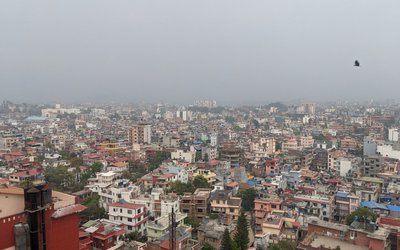Working as a government official in the aftermath of a major earthquake in Dharan in 1988, Amod Mani Dixit, Executive Director of National Society for Earthquake Technology-Nepal (NSET) realized there was a real need to do something from the non-governmental sector for earthquake safety in Nepal. A few years following the quake, Dixit left the government job at National Seismic Center and gathered some like minded people to set up NSET. It is now one of the largest non-governmental organizations working in the area of earthquake safety, not only in Nepal but around the world, offering its technical knowhow. When Dixit set up the NSET, nobody accepted the fact that the earthquakes did not kill people but unsafe buildings did. One can see a massive change in their perceptions now. Dixit spoke to KESHAB POUDEL on various issues related to earthquake. Excerpts:
People think that the earthquake brings devastation and kills people. How do you define an earthquake?
One universal truth is that earthquakes do not kill people but unsafe buildings and other constructions do. If your buildings and infrastructures are earthquake-resistant and constructed by complying with building codes and guidelines, you are safe. There is a often a havoc attached with earthquake. In reality, it cannot destroy or kill people by itself.
What are the economic implications of earthquakes?
Oh, it has major implications. If banks cannot operate for four days during the major earthquakes, the loss will be a lot. Similarly, the loss of insurance money will be much higher. The cost of the damage made by earthquake in star and non-star hotels will be high. If an earthquake of 8 Richter scale hit Seattle of US and Nepal, the two places might have to face different things. There will be a massive human casualty in Nepal and more economic damage in Seattle.
What was the loss like in the recent earthquake?
There was a huge loss in the recent earthquake. The recent quake also partially damaged community buildings like schools, health posts and village development community. Although the quake did not destroy many houses in the valley, it partially damaged many buildings, including the cultural and heritage sites of Kathmandu like the Basantapur Palace. Besides the human loss, NSET estimated that the economic damage of September earthquake is over 7 billion Rupees. This does not include the government property, bridges and other infrastructures. This is direct damage. We don’t know the indirect loss. According to government estimates, the country lost 4.5 billion rupees in the recent earthquake.
You have recently said that Nepal’s overall economy will badly suffer in case of major earthquakes. Even our insurance companies and banks will have to face severe financial crisis. Their data will be badly damaged and the buildings they are living will collapse. What solution do you have to make them safe?
I don’t have any doubt that in case there is a quake like that of 1990 B.S, everyone will be bankrupt. The earthquake of such Richter scale is overdue in the valley. If we don’t take early precautions and prepare, our financial system will be badly hit. Insurance companies and banks will be bankrupt. Even if houses are insured, the devastation will be such large that they will be unable to pay the insured amount. So far as bankers are concerned, they too are much vulnerable. Their data, servers, employees and buildings all are under risk. Even their investments are under risk.
How do you define safety?
There are the issues of in-house safety and investment security. As banks are investing a huge money in infrastructure like apartments, cars, roads, hydro projects, houses and other such areas, they must consider whether the buildings and infrastructures are earthquake-resistant or not before taking decision on investment. Similarly, they also need in-house safety or safety of their data and employees. For this they need to invest to make their places earthquake resistant.
Do you mean there will be a great risk?
If one or two houses are damaged, the banks can reimburse them or they can make a claim from insurance. If there is a hundred percent damage, how can they recover the debt? For instance, our projection is that there will be a damage to 60 percent houses in case of an 8 Richter scale quake.
How about other losses?
There will be irrevocable losses in cultural heritage, social capital or economic prospects. Can cultural and social relations remain similar after the quake? If the courtyard is destroyed in Itumbahal, everything will be destroyed. It will damage everything. We can limit the damage but what is required is to invest taking in mind earthquake safety. For the first time, we have been able to interact with bankers, insurers and others regarding this.
You have been saying this for more than two decades that Nepal in particular is highly sensitive to earthquakes. However, investors are constructing tall buildings and apartments haphazardly. What is your reaction?
I have not been saying that the construction of tall apartments is bad. There is the need more tall apartments in the valley. Now we are constructing apartments of up to 10 or 14 floors. If we can construct apartments of up to 25 floors, there is no harm at all. What is important is, whatever we construct, they should be adaptive to Nepal’s geography. As Nepal is seismically vulnerable, our construction must comply with building codes and guidelines.
How do you look at the apartments coming up here and there?
Buildings should be constructed looking at the conditions of their locations. You cannot construct a 15-storey building near Taleju temple or in the areas adjoining the banks of major rivers. The process of urbanization needs to be guided by land use policy keeping in mind the earthquake risk sensitivity. Buildings should be allowed in specific areas where the process of liquefaction is low. It is the job of the municipalities to develop the land use plan and construction should be made accordingly.
It is reported that after the recent quake, many people were hesitating to move to their apartments. Why was this?
It may be true. Naturally, everyone needs to be afraid of the way of construction of buildings. I have already told you that earthquakes do not kill people but unsafe buildings do. People might have realized that apartments are unsafe or they are constructed without following requirements of normal structural engineering practices. People need to be assured of their safety and security.
Most of the apartments are along the river banks like Balkumari, Sankhamul, Samakhushi and Jamshikhel. Do you think they are safe?
I agree with you that there is the need to be sensitive about the development. The government must regulate apartments. They should be earthquake-resistant. You have to use common sense. I would like to request the banks and insurance companies to use common sense before making decisions on investment. If the investments of the banks are hazardous, they should think about this. Banks should ensure that they will not invest in the housing sector, if that is hazardous.
How was your recent interaction with the banks and financial institutions?
It was a good start. I found that they are aware of the safety issue. What we need to do now is to change our mindset that the government is the doer and others are the watchers and promoters. Actually, this is not true. Doers are those who really do things. It is their responsibility to see what they do is secure. If they invest a little money, the bankers can make themselves safe. Disaster reduction is not a costly affair. It is a one-time investment. If you are smart, you need to look into long term investment.
What is the message of Earthquake Safety Day?
We will evaluate what happened to last 364 days and try to formulate the programs for what we can do in future. Earthquake Safety Day is not there to start and to do something new. It is the day to think about the new technology and safety during earthquakes. The day is for reaffirmation of collective work, commitments to prepare for the future shock. Every next time, the earthquake day brings more people. We have been targeting the common people since its inception where we can share the possible scenario of the valley and what can we do to cope with the situation. We have targeted the government in the last five years in the areas like emergency services. Our focus was Nepal Army, Armed Police Force and Nepal Police to demonstrate collectively in emergency preparedness.
What Nepal needs is a secure development. What Nepal desires is a risk free development.
If there is a major quake in Kathmandu, we will lose our cultural heritage and such important sites. People rebuilt the 55-windows palace of Bhaktapur because there were artisans and other workers available. If a quake destroys the palace, can the country afford to reconstruct it again? The latest quake even partially destroyed Basantapur Palace. Old Pagoda buildings remained intact but the new white places were partially damaged. The government has already set up a committee to look into this.
The issue raised by you that Nepal is earthquake sensitive has become the national agenda now. How do you view this change?
This is a phenomenal success. Fifteen years ago we were solitary singers. Now thousands of people are singing the song. The government has also started singing it. The private sector is also coming to take part in the same orchestra. Over the years, the awareness level has increased tremendously.
How is the demand for earthquake safety?
Demands are coming from schools, hospitals, municipalities, wards and private entrepreneurs. All of them want earthquake safety measures. I am happy that the demand has been created and it has increased a lot. On supply side, we have not been able to do so much for them. I can say that there has been qualitative change.
Is there any change in the construction method?
There is a fundamental change in the construction side. What I can say now is that building construction in the Kathmandu valley is getting better. Of course, it is still not up to the mark or up to our satisfaction level but what I can see is a fundamental change in thinking. We have already trained 5,000 masons as well as other low skilled manpower who know how to construct earthquake safe buildings.
What do you say of the achievements?
The problem is that Kathmandu is building too many houses - approximately 10,000 buildings are added per year. This means all the masons are not able to cater to these demands. Still there have been tremendous accomplishments. As former UN secretary general Kofi Annan said the indicators of risk reduction are only intangible. You always count the number of deaths but not the number of those who survive. Risk reduction means to save the vulnerable construction and vulnerable people. One needs to feel what risk reduction is all about.
- TANAHU HYDROPOWER PROEJCT: A Significant Achievement
- Apr 15, 2024
- AMBASSADOR HANAN GODAR: Sharing Pain With A Nepali Family
- Mar 30, 2024
- VISIT OF KfW AND EIB TO NEPAL : Mission Matters
- Mar 25, 2024
- NEPAL BRITAIN SOCIETY: Pratima Pande's Leadership
- Mar 24, 2024
- NEPAL ARMY DAY: Time To Recall Glory
- Mar 15, 2024
















